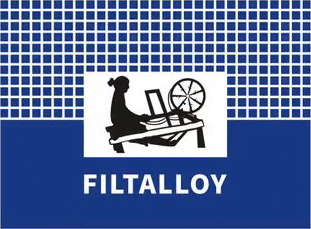Due to the use of perfluorosulfonic acid (PFSA) membrane in PEM electrolysis, the working environment of PEM electrolysis cell tends to be acidic. In addition, the high potential and oxygen release on the anode side form a harsh oxidation environment. Therefore, the bipolar plate, gas diffusion layer and other structures of PEM electrolysis cell need to have corrosion resistance. Optional materials include graphite, stainless steel, titanium, etc., each with its own advantages and disadvantages, and titanium has better comprehensive performance.
Among numerous metal materials, titanium and titanium alloys have the characteristics of low density, high strength, and corrosion resistance. It could resist high temperature up to 1000℃. It can improve electrolysis efficiency, reduce electrolysis costs, and enhance the stability of electrolysis cells. They are one of the indispensable materials in the PEM electrolysis cell industry.
The production process of titanium sintered felt is as follows:
- Selecting high-quality sponge titanium
- Customizing the process to produce titanium crystals according to the metal content requirements of titanium felt
- Forging into the desired shape
- Processing titanium fibers with a titanium plate machine
- Laying titanium fibers
- High-temperature sintering to produce porous titanium felt.
Typically, titanium with electroplated platinum meets durability and performance requirements in high-pressure and oxidizing environments.
1. As gas diffusion layer (GDL)
Titanium sintered felt is commonly used as a gas diffusion layer for cathodes and anodes. The function is to uniformly distribute reaction gases to the catalyst layer, including hydrogen and oxygen. The generated gas is exported to prevent local overheating or performance degradation caused by bubble accumulation.
Provide an electronic conduction pathway while allowing liquid water to pass through to achieve proton conduction.
- High porosity: The high porosity of titanium sintered felt is 50% -80%. It promotes efficient transport of hydrogen, oxygen and liquids.
- High conductivity: The high conductivity of titanium felt ensures uniform distribution of current, reduces contact resistance, and improves electrolysis efficiency.
- Corrosion resistance: Stable in acidic PEM environment and anode high potential (about 2V), avoiding oxidative degradation.
Titanium felt is used to replace traditional serpentine channels to reduce uneven stress inside the electrolytic cell. It ensures the structural integrity of the catalytic layer, which helps improve the performance and stability of the electrolytic cell.
2. As Catalyst Carrier
- Function: Titanium sintered fiber felt can serve as a catalyst substrate, electroplating with precious metal catalysts, such as platinum, iridium, etc. It can enhance the catalytic activity of electrolytic reactions and help reduce the overpotential of electrolytic reactions.
- Advantages: The physical structure is stable and can maintain a porous structure during electrolysis, preventing catalyst aggregation or detachment.
Anti-oxidation: It’s able to withstand strong oxidation conditions on the anode side, such as oxygen evolution reaction and OER.
3. Application in Bipolar Plates
Titanium bipolar plates can be manufactured through etching processes. They are expected to adopt more economical stamping processes in the future.
The working environment of PEM electrolyzer is acidic. Titanium sintered fiber felt can withstand high potential and severe oxidation environment on the anode side.
Function: Titanium sintered felt can be combined with titanium plates to form bipolar plates, replacing traditional graphite or pure titanium plates. It allows electrons to be quickly and efficiently conducted to the electrode surface.It can also ensure continuous and stable electrolytic reactions on the electrode.
The weight of titanium felt is relatively light, which can reduce the weight of the electrolytic cell. Its porous structure can replace some flow field grooves, improving the contact efficiency of reactants.
4. Technical Challenges and Improvement Directions
- Electroplating:At present the titanium sintered fiber felt is electroplating with platinum of 0.5um thickness. It could prolong the Ti felt life and enhance conductivity..Besides, electroplating gold and Titanium Nitride could also implement this function.
- Doping modification:Introducing carbon materials or metal oxides to improve electrochemical performance.
- Passive oxide:A passive oxide layer (TiO2) may form on the surface of bare titanium, increasing resistance. The future direction of technological development is,
Cost issue: The cost of titanium materials is relatively high, but it can be reduced by optimizing sintering processes or combining other materials.
5. Comparison with Other Materials
- Compared to carbon paper: Titanium sintered felt is more stable in acidic PEM environments. While carbon felt has poor corrosion resistance, but its conductivity and cost are not as good as Ti sintered fiber felt materials. requiring coating balance.
- Compared to nickel sintered fiber felt: Titanium is more resistant to anodizing and suitable for high-potential environments. But nickel sintered fiber felt is suitable for alkaline electrolysis cells.
Summarize
Because titanium sintered felt has the ability of corrosion resistance, porous conductive structure and mechanical strength, it’s especially suitable for high current density, high potential and strong acidic environments in PEM electrolysis cells. In the future, with the advancement of surface modification technology and large-scale production, its application will further expand, promoting the high efficiency and commercialization of green hydrogen preparation.


